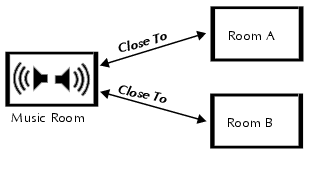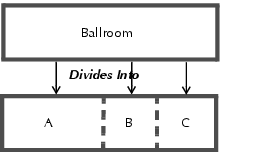This relationship... | Defines... | For example... |
Also Assign  | Other locations that are also automatically assigned to an event when this location is assigned. | You want to ensure that when a particular auditorium is assigned to an event, the lobby adjacent to the auditorium is also automatically assigned to the event. To do this, you would specify that when the auditorium is assigned “also assign” the lobby. |
Also Assign relationships aren’t reciprocal, so in this example the auditorium won’t be automatically assigned when you assign the lobby to an event. If the relationship doesn’t apply to certain event occurrences, the scheduler can remove the assignment of the lobby from one or more occurrences without removing the assignment of the auditorium to those occurrences. | ||
Blocked By  | Other locations, that if already assigned for the same date and time, “block” (prevent) this location from being assigned.  | You want to ensure that if an athletic field has been assigned to an event, the auditorium that shares the same parking lot can’t be assigned to an event meeting at the same date/time because parking is limited. To do this, you would specify that the auditorium is “blocked by” the athletic field. |
Blocked By relationships aren’t reciprocal, so in this example the athletic field won’t be automatically blocked when you assign the auditorium to an event. If you want that, you must specify the blocked by relationship for each related location. In the example above, you would have to also specify that the athletic field is blocked by the auditorium. | ||
Close To  | Other locations that are close to this location. You determine what “close to” means. | You want to ensure that schedulers know which rooms are near a noisy music room to assist them in appropriate event location assignment. To do this, you would specify that the music room is “close to” several other rooms. |
Close To relationships are reciprocal, so in this example the Music Room is close to Room A, and Room A is close to the music room. | ||
Divides Into  | Other locations that are subdivisions of this location and, therefore, can’t be assigned for the same date and time. | You want to ensure that when a large ballroom is assigned to an event, its smaller ballroom components can’t be assigned to other events meeting at the same date and time. To do this, you would specify that the ballroom “divides into” the smaller locations. |
Divides Into relationships are reciprocal with Subdivision Of relationships, so in this example when you establish that the Ballroom divides into Ballrooms A, B, and C, each of the smaller locations is defined as a subdivision of the Ballroom. 25Live treats an event in any of the smaller locations as an event in the larger location, and vice versa. In this example, users could potentially reserve any of these locations, if available: • Ballroom (includes A, B, and C) • Ballroom A • Ballroom B • Ballroom C • Ballroom A/B • Ballroom B/C | ||
Best Practice: When you set up Divides Into relationships for a group of locations, it’s a good practice to also set up Close To relationships among them. | ||
Subdivision Of  | Locations that are part of a larger location and, therefore, when assigned to an event, prevent the larger location from being assigned for the same date and time. It would not prevent other subdivisions of the larger location from being assigned for the same date and time. | You want to ensure that when a subdivision of a larger ballroom is assigned to an event, the location(s) of which it’s a part can’t be assigned to an event meeting at the same date and time. Once you set up the Divides Into relationships among the Ballroom locations as shown in the previous example, the Subdivision Of relationships are established automatically. |
Subdivision Of relationships are reciprocal with Divides Into relationships. See explanation on
page 54. | ||